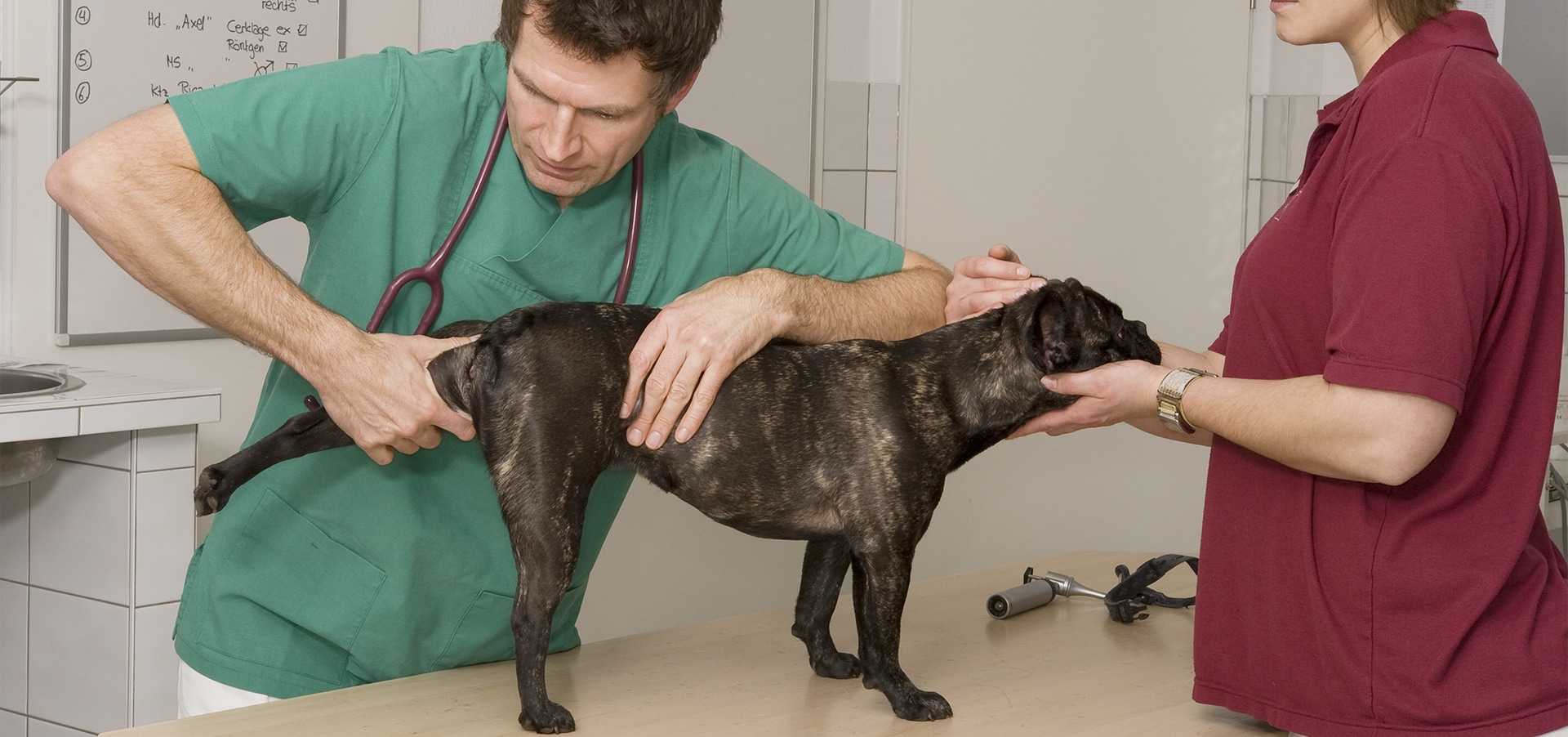Hip Dysplasia in Dogs
Free Pet Insurance Comparison
Compare Quotes From Top Companies and Save
Secured with SHA-256 Encryption

Dr. Pippa Elliott BVMS, MRCVS
Veterinarian
Dr Pippa Elliott BVMS, MRCVS is a veterinarian with over 30 years of experience in companion animal practice. In 1987 she graduated from the University of Glasgow, with a degree in veterinary medicine and surgery. She works at Blythwood Vets and the People’s Dispensary for Sick Animals (PDSA). Pippa is an advocate of Fear-Free Practice, an animal addict, and a veterinary writer. She is also w...
Veterinarian
UPDATED: Jan 8, 2024
Pet Insurance U receives compensation from the third parties included on this site. This includes payment for clicks from our site to insurance providers’ sites and quote requests generated. Our rankings and reviews are not affected by payments from the insurance companies. The compensation we receive allows the site to be free and regularly updated. Our goal is to review every pet insurance provider, but not all companies are listed on the site.
And many of the companies we review do not pay us anything. We simply rate, compare and review their plan because we feel it will be valuable to you. Our reviews are guaranteed to be unbiased, professional and advertising compensation does not influence rankings.
We are a free online resource for anyone interested in learning more about pet insurance. Our goal is to be an objective, third-party resource for everything pet insurance related. We update our site regularly, and all content is reviewed by pet insurance experts.
UPDATED: Jan 8, 2024
Pet Insurance U receives compensation from the third parties included on this site. This includes payment for clicks from our site to insurance providers’ sites and quote requests generated. Our rankings and reviews are not affected by payments from the insurance companies. The compensation we receive allows the site to be free and regularly updated. Our goal is to review every pet insurance provider, but not all companies are listed on the site.
And many of the companies we review do not pay us anything. We simply rate, compare and review their plan because we feel it will be valuable to you. Our reviews are guaranteed to be unbiased, professional and advertising compensation does not influence rankings.
On This Page
You know that feeling when you take your dog for a walk, your pup starts to slow down a bit, and his gait is a little off?
The usual culprit is your dog’s hips.
Here’s what you need to know about your dog’s precious, necessary, and sensitive hips:
They’re EXPENSIVE to treat if something goes wrong.
Not to mention the pain and suffering your poor canine best friend has to go through.
So that’s some of the bad news.
The good news?
It’s possible to treat hip dysplasia early and possibly even help prevent it. And pet insurance can help you achieve both of those goals.
Table of Contents:
Related: 10 Things You Must Know Before You Buy Pet Insurance
What is Hip Dysplasia?

Hip dysplasia is a condition that occurs when the “ball and socket” hip joint doesn’t function properly. The leg bone and hip don’t fit together correctly as in a dog with healthy hips.
A healthy dog hip has a soft cushion of cartilage lining the hip joint where the leg bone rests.
The head of the leg bone forms with the part of the socket that it is held in place by a strong ligament joint.
Healthy hips joints are lubricated, and movement is not painful. In dogs with hip dysplasia, the ball and socket don’t fit as they should.
Typically, these dogs are born with normal-looking hips, but over time, the bone pops out of place and causes several issues.
The hip joint isn’t as deep as healthy dogs, so the bone easily comes out of its socket. Also, the ligaments aren’t as strong, making it more difficult to keep the bones in place.
Over time, this rubbing of bones wears down the cartilage cushion and becomes very painful for dogs.
Enter your ZIP code below to view companies that have cheap pet insurance rates.
Secured with SHA-256 Encryption
What Causes Hip Dysplasia in Dogs?
Hip dysplasia in dogs is a hereditary condition that gets worse as a dog ages.
It is one of the most prevalent health conditions in dogs, likely due to poor breeding standards that don’t remove dogs with hip dysplasia from the breeding pool.
Symptoms of Hip Dysplasia
If possible, it’s good to be aware of the history of hip dysplasia that occurred in your dog’s parents and breeding line.
Whether or not you have that information, watch out for these crucial physical symptoms of hip dysplasia:
- Pain or discomfort when exercising
- Reluctance to engage in physical activity
- Favoring the legs or hips when active, sitting, or lying down
- Lameness
- Back legs get very stiff during activity
- Running that looks like hopping
- Difficulty getting up
- Muscle loss in hind legs
- Decreased interest in activities your dog used to enjoy
Dogs Most Likely to Suffer From Hip Dysplasia
Some dogs are more genetically disposed to hip dysplasia.
Large breed dogs put more stress on their hips and are more likely to suffer from the condition.
The breeds most prone to hip dysplasia include:
- Labrador Retrievers
- Golden Retrievers
- German Shepherds
- Great Danes
- Bulldogs
- Mastiffs
- St. Bernards
- American Staffordshire Terriers
- Rottweilers
- Pugs
Treatment of Hip Dysplasia
Surgery is the most common treatment option for hip dysplasia, especially for more severe cases of the disorder.
Depending on your dog’s age, there are a few surgical options:
JPS – Juvenile Pubic Symphysiodesis
This surgery is performed on puppies with hip dysplasia that are under five months old.
Juvenile Pubic Symphysiodesis changes the angle of the hips in order and enables the bones located in the pelvis to develop correctly.
TP0 – Triple Pelvic Osteotomy
Triple Pelvic Osteotomy is performed in puppies under ten months old with hip dysplasia and is more invasive the Juvenile Pubic Symphysiodesis.
In a TPO procedure, an orthopedic surgeon realigns the femur to the hip socket and does this by breaking the pelvis.
TPO is most successful in younger dogs because it can restore hip function fully. However, it can be a painful surgery and expensive.
Femoral Head and Neck Excision Surgery
This surgery is recommended for older, lighter dogs.
The femoral head and Neck Excision does not restore full function of the hips, but it does dramatically reduce pain due to hip dysplasia.
The top (or head) of the pup’s leg bone is removed and replaced with a more flexible joint for a better fit with the hip.
Total Hip Replacement Surgery
Total Hip Replacement is a costly surgery and is also the most intrusive procedure to treat canine hip dysplasia.
However, it has the benefit of restoring the hip completely, even in dogs with severe degradation of their hip joint.
As in humans, a total hip replacement in dogs involves the complete removal of the hip joint and puts an artificial join in its place.
The recovery is extensive, but dogs with this kind of hip surgery can enjoy activity pain-free.
Enter your ZIP code below to view companies that have cheap pet insurance rates.
Secured with SHA-256 Encryption
Are There Any Alternative Treatments for Dog Hip Dysplasia?
For less severe cases of hip dysplasia, surgery may not be necessary. Additionally, if pet owners cannot afford surgery, or if they do not have pet health insurance to cover the cost of surgery, surgical alternatives may include:
- Physical Therapy
- Hydrotherapy
- Exercise
- Weight loss and weight management
- Nutritional supplements
The Cost to Treat Hip Dysplasia
The treatment for hip dysplasia can be costly and cost anywhere from $2,000 to $5,000.
The costs not only include the surgery that is needed but also the care post-surgery.
There is the additional physiotherapy, vet visits as well as prescription medication necessary.
The cost can range anywhere from $2,500 to $5,000 and usually is contingent on other additional factors such as the severity of the condition and the city where you live.
Will Pet Insurance Cover Hip Dysplasia?
Yes, hip dysplasia is covered as long as the condition is not considered pre-existing.
If it occurs in one hip, then, unfortunately, the other one will not be covered.
Pet insurance is excellent for those breeds that are genetically predisposed to hip conditions that could occur as the breed matures.
With plans like Healthy Paws, you can save up to 90% on the actual surgery as well as the rehab that might be needed post-surgery.
Real Cost Savings from PetFirst Clients

Luna
PetFirst saved his parents
$6,712
A happy energetic Luna one morning couldn’t hold her food down. After months of multiple costly vet visits to specialists and an endoscopy, the problem was discovered and fixed. Luna put 22 pounds back on in no time and her parents were grateful for having PetFirst by their side to pay the bills.
Enter your ZIP code below to view companies that have cheap pet insurance rates.
Secured with SHA-256 Encryption
Other Things to Know About Hip Dysplasia
- Hip dysplasia can occur in more than 50 percent of larger breed dogs.
- Genetic selection by breeders can reduce Hip Dysplasia risk by up to 2/3.
- Over 72% of English Bulldogs have been diagnosed with Hip Dysplasia.
- More than 66 percent of pugs were diagnosed with hip dysplasia from 1974 through the end of 2010.
- While the average cost of hip replacement surgery weighs in at $5,000, the price can be substantially higher depending on your dog’s breed and where you live.
Final Thoughts on Hip Dysplasia in Dogs
Hip dysplasia is a very common condition in big dogs and even older ones. Because it is so expensive to treat, pet insurance is a great way to help offset some of those costs.
The last thing you want is for your dog to be in pain. Or that you are in the position where you can’t pay for the treatment and relief your dog needs.
The best thing you can do for a big dog or any dog breed that is predisposed to hip dysplasia is to sign up for pet insurance when he or she is a puppy and before the condition might occur.
If you are looking for a pet insurance company that covers hip dysplasia, our top 10 pet insurance companies is a great place to start!
Other articles you may find helpful:
Is Exotic Pet Insurance Necessary?
The Best Pet Insurance By State
Fun Facts, Dog FAQ, And Unsolicited Dog Advice
5 Training Commands to Save Your Dog’s Life
The Ultimate Guide to Safe Foods for Dogs
We get it, your dog is like your child and when your puppy or dog has health problems it is scary. Luckily there is pet insurance companies that will help you pay for any veterinarian care they made need. Checkout the best puppy and dog pet insurance companies and learn about common puppy health issues and ailments in older pets.
Common Health Problems:
Chronic Active Hepatitis in Dogs
Cruciate Ligament Tear in Dogs
Degenerative Myelopathy | Spinal Cord Disease In Dogs
Dementia in Dogs | Canine Cognitive Dysfunction
Dog Comedones (Schnauzer Bumps)
Dog Diarrhea: What Can You Do To Help?
Gallbladder Obstruction in Dogs
Heart Murmurs In Dogs | How To Identify Them
Intervertebral Disc Disease In Dogs
Nasal Solar Dermatitis In Dogs
Progressive Retinal Atrophy In Dogs
The Dog Flu – Symptoms & Treatment for Canine Influenza
Frequently Asked Questions
What is Hip Dysplasia?
Hip dysplasia is a condition where the “ball and socket” hip joint in dogs doesn’t function properly. The leg bone and hip don’t fit together correctly, leading to pain and joint issues.
What causes Hip Dysplasia in Dogs?
Hip dysplasia is primarily a hereditary condition that worsens as a dog ages. Poor breeding standards can contribute to its prevalence, and large breed dogs are more genetically disposed to hip dysplasia.
What are the Symptoms of Hip Dysplasia in Dogs?
Symptoms include difficulty walking, reluctance to go on walks, and visible pain during movement. It’s essential to be aware of the dog’s breeding history and watch for physical signs like limping.
What breeds are Most Likely to Suffer from Hip Dysplasia?
Large breed dogs, due to the stress on their hips, are more prone to hip dysplasia. Breeds like Labrador Retrievers, German Shepherds, and Golden Retrievers are commonly affected.
How is Hip Dysplasia Treated?
Treatment options include surgery, such as Juvenile Pubic Symphysiodesis (JPS), Triple Pelvic Osteotomy (TPO), Femoral Head and Neck Excision Surgery, and Total Hip Replacement Surgery, depending on the dog’s age and severity of the condition.
Are there Alternative Treatments for Dog Hip Dysplasia?
For less severe cases, surgery may not be necessary. Alternative treatments include weight management, physical therapy, joint supplements, and medications.
What is the Cost to Treat Hip Dysplasia?
The cost can range from $2,000 to $5,000, covering surgery, post-surgery care, physiotherapy, vet visits, and prescription medications.
Will Pet Insurance Cover Hip Dysplasia?
Yes, pet insurance can cover the costs of treating hip dysplasia, provided it’s not considered pre-existing. Some plans, like Healthy Paws, may cover up to 90% of surgery and rehabilitation costs.
What Dogs are Most at Risk for Hip Dysplasia?
Large breed dogs, especially those with a genetic predisposition, are most at risk for hip dysplasia. It’s crucial to consider the breed’s susceptibility when choosing pet insurance.
How Can Pet Insurance Help with Hip Dysplasia?
Pet insurance can offset the expensive treatment costs associated with hip dysplasia, ensuring that your dog receives the necessary care without causing financial strain.
Enter your ZIP code below to view companies that have cheap pet insurance rates.
Secured with SHA-256 Encryption
Dr. Pippa Elliott BVMS, MRCVS
Veterinarian
Dr Pippa Elliott BVMS, MRCVS is a veterinarian with over 30 years of experience in companion animal practice. In 1987 she graduated from the University of Glasgow, with a degree in veterinary medicine and surgery. She works at Blythwood Vets and the People’s Dispensary for Sick Animals (PDSA). Pippa is an advocate of Fear-Free Practice, an animal addict, and a veterinary writer. She is also w...
Veterinarian
We are a free online resource for anyone interested in learning more about pet insurance. Our goal is to be an objective, third-party resource for everything pet insurance related. We update our site regularly, and all content is reviewed by pet insurance experts.
